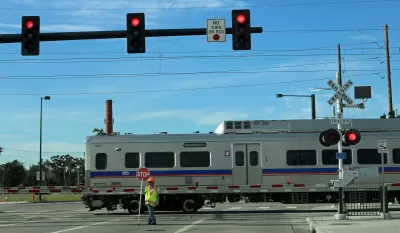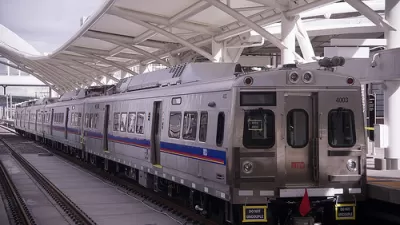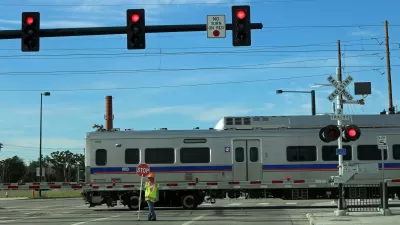In a region with a full calendar of transit construction projects and high hopes for a positive stream of news, a premier and historic project has not gone as smoothly as hoped.

John Aguilar reports: "The price tag to man the 11 at-grade crossings along the 23-mile train route out to Denver International Airport since it opened a year ago: nearly $6 million and counting, according to calculations made by The Denver Post."
The high price tag isn't being paid by taxpayers (the Regional Transportation District's private sector partner Denver Transit Partners gets that privilege), but it's "perhaps the most visible and vexing sign that the state’s pre-eminent transit project has had a far rockier rollout than many had hoped."
Moreover, the problems with the gates have "ripple effects" to other parts of the RTD's capital investment program. According to Aguilar, "[a]s long as hang-ups persist with the timing of the gates that stop motorists from driving onto the tracks, there can be no progress on opening the G-Line to the western suburbs."
The cost comes from stationing officers in both the Denver and Aurora police departments at the crossings, as well as flaggers. RTD and Denver Transit Partners officials have not set any timetable for the reduction of staffing requirements at the A-Line's grade crossings.

Rethinking Redlining
For decades we have blamed 100-year-old maps for the patterns of spatial racial inequity that persist in American cities today. An esteemed researcher says: we’ve got it all wrong.

Planetizen Federal Action Tracker
A weekly monitor of how Trump’s orders and actions are impacting planners and planning in America.

California High-Speed Rail's Plan to Right Itself
The railroad's new CEO thinks he can get the project back on track. The stars will need to align this summer.

Santa Clara County Dedicates Over $28M to Affordable Housing
The county is funding over 600 new affordable housing units via revenue from a 2016 bond measure.

Why a Failed ‘Smart City’ Is Still Relevant
A Google-backed proposal to turn an underused section of Toronto waterfront into a tech hub holds relevant lessons about privacy and data.

When Sears Pioneered Modular Housing
Kit homes sold in catalogs like Sears and Montgomery Ward made homeownership affordable for midcentury Americans.
Urban Design for Planners 1: Software Tools
This six-course series explores essential urban design concepts using open source software and equips planners with the tools they need to participate fully in the urban design process.
Planning for Universal Design
Learn the tools for implementing Universal Design in planning regulations.
City of Camden Redevelopment Agency
City of Astoria
Transportation Research & Education Center (TREC) at Portland State University
Regional Transportation Commission of Southern Nevada
Toledo-Lucas County Plan Commissions




























